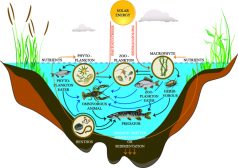Definition
noun, plural: luciferases
Any of the group of enzymes that act on the oxidation of luciferin of bioluminescent organisms
Supplement
There are organisms that are capable of producing and emitting light. The production and emission of light is called bioluminescence and organisms capable of this are described as bioluminescent. Fireflies are well-known bioluminescent organisms. Adult fireflies use bioluminescence as a means to attract prey and mate. They are able to it because they have the enzyme luciferase. Luciferases are enzymes that act to bring about the oxidation of luciferins. The energy produced in the process is liberated as bioluminescence. Such enzymes can be used to detect very low concentrations of metabolites. The chemical reaction is as follows: (1st step) luciferin reacts with ATP to produce luciferyl adenylate and PPi, and (2nd step) luciferyl adenylate reacts with O2 resulting in the production of oxyluciferin in electronically excited state and AMP. When oxyluciferin returns to its ground state it releases a photon of light.
Etymologically, the name luciferase is derived from Lucifer, i.e. from lucem ferre which means ‘light-bearer’. Luciferases are different from photoproteins, which are also involved in bioluminescence. Photoproteins do not show typical enzyme kinetics such as observed in luciferases.
See also:
- bioluminescence
- luciferin







